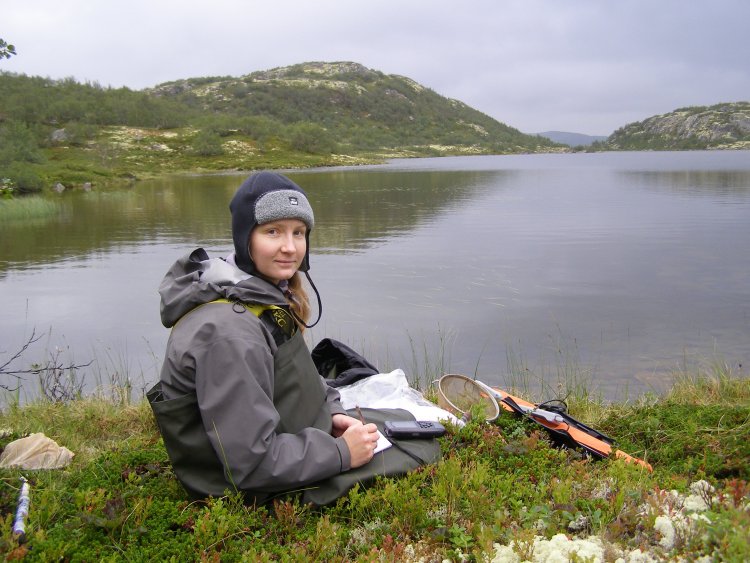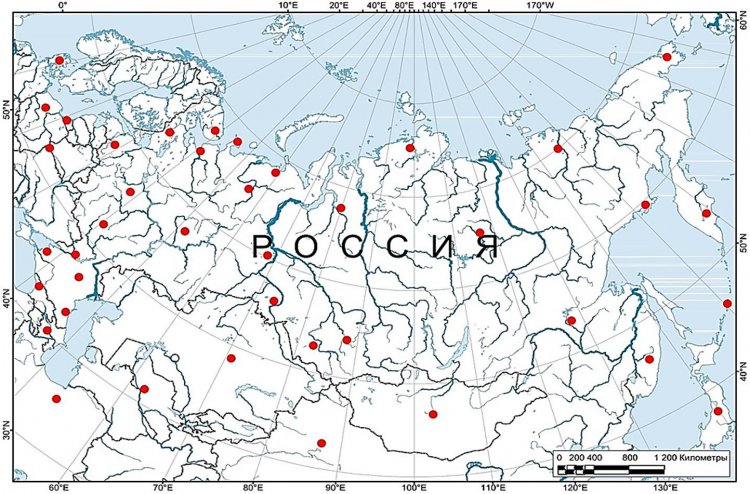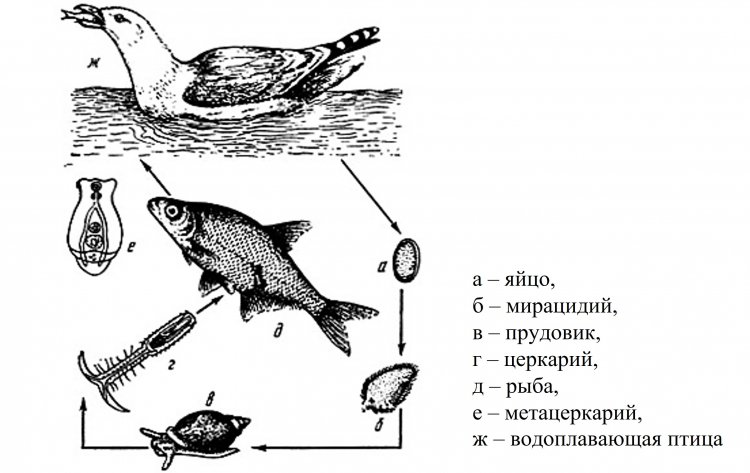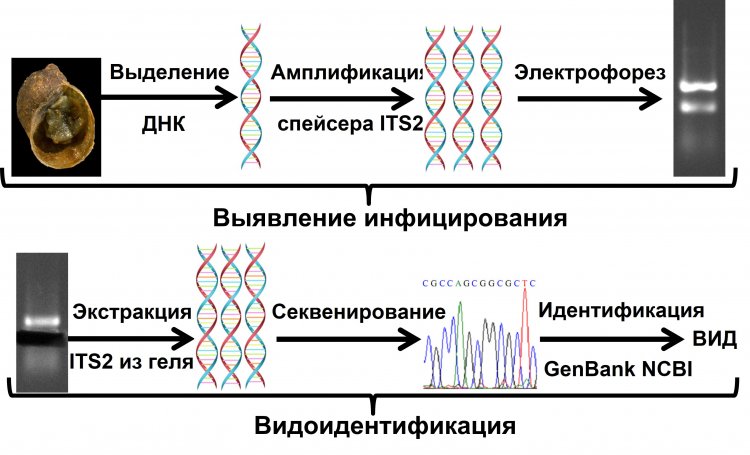Arkhangelsk scientists have proposed a method for detecting and identifying trematodes in freshwater snails without any visual examination; this will help assess the parasitic situation in the environment
The gastropods of the Lymnaeidae family, or pond snails, which are found everywhere, including the Arctic, can act as intermediate hosts for certain parasite species. During the migration of animals, like fish and birds, parasites can spread from one region to another. Most often, such representatives of the parasitofauna are trematodes – a class of parasitic flatworms numbering several thousand species. They are a source of dangerous diseases in animals and humans. Therefore, we need new methods to identify parasites both for preserving biodiversity in general and for ensuring ecological safety of the Arctic territories.
While studying samples of pond snails in different areas of the Arctic region, specialists of FECIAR UrB RAS (Arkhangelsk) found specimens infected with trematode partenites. The scientists developed an original method based on their laboratory studies, which was granted a patent for, making it possible to detect infected pond snails and carry out the parasite species identification.
Alexander Vasilyevich Kondakov, PhD (Technical Sciences)
Scientists from the Institute of Biogeography and Genetic Resources of the N. Laverov Federal Center for Integrated Arctic Research of the Ural Branch of the Russian Academy of Sciences (Arkhangelsk) – Alexander Vasilyevich Kondakov, PhD (Technical Sciences), leading researcher of the Laboratory of Molecular Ecology and Biogeography, and Olga Vladimirovna Aksenova, PhD (Biology), leading researcher of the Russian Museum of Biodiversity centers – spoke about the study results regarding trematodes in the body of freshwater gastropod mollusks of the Lymnaeidae family and the effective molecular genetic method proposed by the group of authors for determining the species composition of internal trematode parasites found in vertebrate and invertebrate animals.
Olga Vladimirovna Aksenova, PhD (Biology)
According to Alexander Kondakov, “people often think of parasites when they somehow become infected with trematodes or find them in fish, game, or farm animals, for example. However, it is known from school biology programs that trematodes have a complex life cycle with a change of intermediate hosts, one of which is usually freshwater gastropod mollusks, which we call pond snails or just snails. And initially our research was aimed at detecting trematodes in pond snails by molecular methods in general. However, in one of our works we combined the data obtained on these animals in the Arctic, since this issue is really urgent at the moment.”
“We all have heard about climate change more than once, and most clearly it is seen in the Arctic. The changes occurring here can activate such processes as an increase in the number of parasites and their vectors, partial or complete replacement of the host parasitofauna, as well as penetration of parasites into new territories. Many researchers note more and more often the appearance of animal and plant species that have not previously been found here. Mollusks and trematodes developing in them are no exception, as they have an opportunity to pass the complete life cycle in our northern bodies of water, and thus eventually get into the human or animal body. In this regard, detection and determination of the parasite species composition in the Arctic territories is of great importance for assessing the existing parasitic situation and forecasting its changes in order to prevent infestations,” Olga Aksenova adds to her colleague's answer.
By examining pond snails (about 700 samples have been analyzed to date), specialists found parasites in their organs and tissues. The percentage of mollusks infected by trematode partenites averaged about 12%, i.e., almost every tenth specimen of those studied was infected.
For the most part, as Alexander Kondakov noted, “trematodes are studied in their sexual maturity, when they are found in animals. But there are specialists who study the full life cycle of parasites, and in this case, there is no way to do without pond snails. They (pond snails) are collected, placed in containers with water and watched for the emergence of trematode larvae, which are examined and used to study the morphological features and carrying out genetic analyses.”
The material for the study by FECIAR UrB RAS was collected during numerous expeditions in different parts of Russia: from Murmansk Region to Chukotka, as well as abroad (for example, in China, Korea, and the United States). The studies were supported by several grants, including the grant of the President of the Russian Federation #MK-1720.2019.4 Study of taxonomic and genetic diversity of gastropods of the Lymnaeidae family as intermediate hosts of trematodes using modern molecular-genetic and biogeographic approaches and continue in the framework of the Russian Science Foundation project #21-74-10155 Freshwater mollusks of Russia: integrative taxonomy, biogeography, ecology, and parasitofauna.
Research area: red dots mark the places where pond snails were collected in the course of expedition surveys.
Which region/area has the most pond snails infested with trematodes and why?
“Trematode diseases are considered to be diseases caused by trematodes and are most common in tropical countries, whereas in Russia they occur in Siberia and the Far East. But it should be noted that pond snails are not always the cause. Other gastropod families also act as intermediate hosts and this is associated more with the natural features of the regions that contribute to a greater diversity of intermediate hosts and facilitate trematode development in them. As for the pond snails, it is still difficult to distinguish the regions where they are more and less infested, since the study began relatively recently, but they are common in almost every body of water,” Olga Aksenova informed.
Alexander Kondakov notes, “there are no regions where we observe high infection of pond snails with trematodes. In general, the percentage of infected mollusks is about 12% everywhere. The exceptions are artificially heated water bodies (TPP cooling channels), in which we did not find any mollusks infected with trematodes. Perhaps, it is related to the high temperatures in these bodies of water, which trematodes are not able to tolerate.”
Common pond snail (Lymnaea stagnalis) in one of the bodies of water in the south of the Taimyr Peninsula.
How do pond snails carry the presence of trematodes in their bodies: get sick, die? “There are several interesting studies on this issue. One of them states that when a mollusk is infected with trematodes in the early stages of development, its growth slows down and, as a result, the shape of its shells changes. Another study determined that trematodes perform chemical castration of pond snails, which means that the pond snails cannot reproduce, they continue to live and feed, but they do not spend energy on reproduction. But it should be clearly understood that it is not in the interest of trematodes to severely depress the intermediate host, because they feed on it,” Alexander Kondakov answered.
“Initially a free-floating larva of the trematode myracidium finds the mollusk in the water and penetrates its body and then begins to develop and reproduce there. This usually takes place in the mollusk's sex gland or digestive system. Eventually they reach large numbers and fill the mollusk's internal body cavity and this definitely weakens it, its immunity, affects its activity, behavior and lifespan. There are examples when infected pond snails reach incredibly large sizes, i.e., trematodes accelerate its development to the onset of sexual maturity and then begin to actively develop in it themselves,” Olga Aksenova continued.
Why do trematodes choose mollusks of the Lymnaeidae family?
“In fact, trematodes also use other gastropod families as intermediate hosts. It is difficult to say for sure why they mainly choose Lymnaeidae mollusks as intermediate hosts. It is just that our study focused on this family as the most common, but insufficiently studied. Most likely, it is related to coevolutionary processes, which led to the fact that mollusks were the optimal organism for the development of certain stages of trematodes,” Alexander Kondakov commented.
Where are the trematodes predominantly found: on the mantle or on the internal organs of pond snails?
“Trematodes in infested mollusks are usually localized in the internal organs, in the digestive system (hepatopancreas), in the sex gland (gonad) and in the muscle tissue (leg) of the mollusk. Often, they can also be found under the mantle, but usually the mollusk needs to be opened to see if it is infected or not,” Olga Aksenova specified.
How do trematodes differ from other worms and what are their morphological features?
“Trematodes, also called flukes, are a large class of parasitic flatworms. There are over 2000 species. A characteristic feature of this group is a complex life cycle in which parthenogenetic and hermaphroditic generations alternate in a number of hosts, the so-called heterogony. During their life cycle, trematodes can have from one to three or four hosts. They invade members of a wide variety of systematic and ecological groups of terrestrial, freshwater and marine vertebrates, causing severe, sometimes fatal diseases in their hosts. As for the morphological features of their structure, this question is rather complicated. The thing is, depending on the development stage and the trematodes species, they differ significantly in appearance.
Diagram of the life cycle of trematodes of the Diplostomum genus. Source: Descriptor of parasites of freshwater fish in the USSR
If we talk about the adult stage (marita), which we can usually find in meat or internal organs of vertebrate animals, including humans, then their body shape is flattened and can be different depending on the family: pear-shaped, leaf-shaped, or filamentous. As a rule, they have oral and abdominal suction cups on their bodies, but again, not all of them. Their size can vary from a few millimeters to several centimeters. At the free-floating larvae stage of miracidia before entering an intermediate host – for example, their body is covered with sensitive villi; at the cercaria stage – after developing in a mollusk, they grow a tail, which in different species may also be filamentous or split at the end; at the metacercaria stage, when the trematode develops in a second intermediate host – the tail falls off. In other words, it is quite difficult to identify any clear signs that would make it easy for a non-specialist to see and identify a trematode,” Olga Aksenova gave detailed information.
According to scientists, the presence of trematodes in mollusks indicates the unfavorable parasitic situation in a body of water or in the region as a whole. In other words, if there are trematodes in mollusks, the final host is likely to be infected sooner or later. It can be fish, birds, cattle, or humans. Most often trematodes are spread by birds, which carry the parasites over long distances.
What is the risk of infecting humans and animals with them?
“There is always a risk of infection with trematodes. For humans, the source of infection can be raw meat or fish, or one can simply swim in a body of water with trematodes. There are trematode species that can penetrate the skin, or a person or animal can simply swallow the larvae with water or plants,” Olga Aksenova answered.
“There is an interesting statistics that shows a direct correlation between the increase in the consumption of raw fish in the form of sushi and the number of parasitic diseases in humans. Therefore, it is not safe to consume raw fish and meat as food. And animals are less protected from parasites than humans, as they often eat plants and drink water directly from a body of water,” Alexander Kondakov said.
Modern research practice uses various molecular genetic methods for the identification of trematodes. FECIAR UrB RAS employees have developed and patented an original method for the detection and identification of trematodes in mollusks without carrying out visual examination. Thus, during the study period 24 trematode species belonging to 12 genera were found.
As Alexander Kondakov notes, “There are no methods that allow us to detect a wide range of trematodes at the same time. The method we developed makes it possible to detect almost all known trematodes in pond fish and carry out their identification. This is the advantage of our method. It makes it possible to determine the presence and species composition of trematodes in fresh water bodies at early stages of their development regardless of their phase through the molecular genetic analysis of mollusks that serve them as intermediate hosts.”
Algorithm of detection and identification of trematodes in mollusks of the Lymnaeidae family
What is the basis of your approach and how do you determine belonging to different biological species?
“The method essence is the following: we take mollusk samples from a body of water, then we isolate DNA from them in the laboratory and perform amplification (increase in the number of DNA copies) using a polymerase chain reaction (PCR). As a result, by analyzing the products obtained in the reaction, we can already see on an electrophoregram whether the mollusk is infected or not. Roughly speaking, if we see one band in the pattern, the mollusk is not infected, if we see two or more bands, the mollusk is infected. If we want to determine the species of mollusk and/or trematode, then we prepare the product and perform sequencing, i.e., after reading the obtained DNA fragments of the selected marker genes and comparing them with the information available in the international GenBank database, we find out the species belonging of the samples we are interested in,” Alexander Kondakov revealed the details of the author's approach.
Electrophoregram with the results of amplification of ITS2 ribosomal DNA genetic marker.
What proves the reliability and accuracy of your method?
“The reliability and accuracy of our method is confirmed by the results obtained. The obtained DNA nucleotide sequences are like a barcode and allow us to identify the species almost unmistakably if the information about it is available in the database; or to understand that we are dealing with a new, still understudied species. This happens too,” the scientist explained.
How are the molecular data obtained on pond snail populations important from a parasitological point of view? How does this information contribute to the understanding of the actual distribution of certain trematode species?
“The obtained molecular data on pond snail allow us to determine the species composition of mollusks in the studied region or a separate body of water. By analyzing the accumulated data, we can reconstruct the pathways of their settlement, determine the peculiarities of evolution of this group, and specify their taxonomic status. The identification of mollusk species allows us to determine the presence or absence of trematodes specificity in relation to mollusk hosts, which is important when studying the coevolution of these groups or when organizing sanitary measures. The data on the trematode species composition, the spectrum of their intermediate hosts and their distribution will make it possible to develop more effective control measures. The study results are of great practical importance for evaluating and monitoring the sanitary and epidemiological state of body of water surface and for preventing human and animal infestations,” Olga Aksenova and Alexander Kondakov, specialists of FECIAR UrB RAS, are convinced.
So, a timely and accurate identification of parasites in vertebrates and invertebrates using a reliable molecular identification will make it possible to develop the measures to minimize the risks of human and animal infection.
*All images are provided by Olga Aksenova and Alexander Kondakov




























